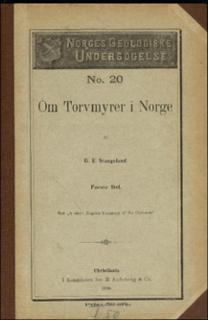| dc.contributor.author | Stangeland, Gustav E. | |
| dc.date.accessioned | 2020-08-26T12:47:16Z | |
| dc.date.available | 2020-08-26T12:47:16Z | |
| dc.date.issued | 1896 | |
| dc.identifier.uri | https://hdl.handle.net/11250/2674656 | |
| dc.description.abstract | Forkortet: 1. The method of investigation. Maps of the mosses are made to the scale of 1:5000 and printed in the scale of 1:20 000. The depths are stated by borings, and specimens from the different layers studied. The chief purpose is to ascertain the practical use to be made out of the mosses, and the author has not made any minute botanical study of the plants, which enter in the composition of the peat. 2. Classification. 1.Moss-peat (mostly consisting of Sphagnum). 2.\"Grass-peat\" with two subdivisions a. Carex-peat. b. Equisetum- peat. 3. Scirpus- and Eriophorum-peat. 4. Forest-peat (rich in roots, stems, leaves and beanches of trees). | |
| dc.language.iso | nor | |
| dc.relation.ispartofseries | NGU (20) | |
| dc.rights | Navngivelse 4.0 Internasjonal | |
| dc.rights.uri | http://creativecommons.org/licenses/by/4.0/deed.no | |
| dc.subject | METODE | |
| dc.subject | TORV | |
| dc.subject | AVSETNING | |
| dc.subject | BORING | |
| dc.title | Om torvmyrer i Norge og deres tilgodegjørelse. Første del | |
| dc.type | Journal article | |
| dc.description.localcode | 36127 | |
| dc.source.pagenumber | 1-120 | |

